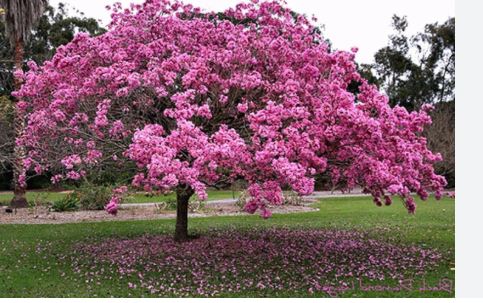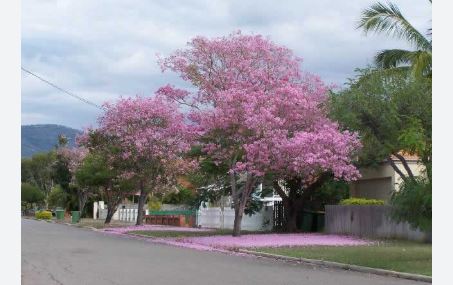
The Tabebuia tree, commonly known as the Trumpet Tree, belongs to the Bignoniaceae family and the genus Tabebuia, encompassing about 100 species. Notable for their trumpet-shaped flowers in pink, yellow, or purple, these deciduous or semi-evergreen trees grow 15–80 feet tall with pinnate or palmate leaves. Species like Tabebuia rosea and Tabebuia chrysotricha are prized for vibrant spring blooms, often flowering when leafless, with slender seedpods and smooth bark enhancing their appeal.
Native to Central and South America, from Mexico to Brazil and Argentina, Tabebuia trees thrive in tropical rainforests, dry forests, and savannas. Widely cultivated in regions like Florida, Hawaii, India, and Southeast Asia, they have naturalized in many tropical and subtropical areas but are rarely invasive. Their adaptability to diverse soils and climates makes them popular ornamental trees globally.
Tabebuia trees have been valued since pre-colonial times in the Americas, with species like Tabebuia impetiginosa (Pau d’Arco) used for wood and traditional medicine. Spread globally by European botanists, they are now iconic in tropical landscapes, with Tabebuia rosea as El Salvador’s national tree. Their vivid blooms feature in festivals, especially in India and Central America.
Tabebuia trees are ideal for specimen planting, shade, and streetscapes in USDA Zones 9b–11, requiring full sun and well-drained soil. Moderately fast-growing (2–4 feet/year), they bloom in 3–5 years from seed. Plant in spring, water regularly until established, and prune after flowering. Protect from frost and manage fallen blooms to maintain tidy landscapes.

Tabebuia (Trumpet) Trees
Tabebuia rosea (Pink Trumpet Tree)
Tabebuia rosea, commonly known as the Pink Trumpet Tree, is one of the most widely cultivated Tabebuia species, prized for its stunning pink to lavender flowers. Native to Central and South America, from Mexico to Venezuela and Ecuador, this deciduous tree grows to 20–80 feet tall with a rounded canopy spanning 15–25 feet.
Its palmate leaves consist of five to seven elliptic leaflets, and in spring (March–May), it produces clusters of trumpet-shaped, pinkish-purple flowers, 2–3 inches long, often blooming when leafless for maximum impact. The tree’s smooth, grey bark and slender seedpods add to its aesthetic appeal.
As the national tree of El Salvador, Tabebuia rosea is a favorite for streetscapes, parks, and gardens, thriving in USDA Zones 9b–11. Its moderate growth rate and drought tolerance make it ideal for tropical and subtropical landscapes, though it requires well-drained soil and full sun.
Tabebuia chrysotricha (Golden Trumpet Tree)
Tabebuia chrysotricha, or the Golden Trumpet Tree, is a compact species renowned for its brilliant yellow flowers that create a dazzling spring display. Native to Brazil and northern Argentina, this deciduous tree typically reaches 15–25 feet in height with a 10–15-foot canopy, making it suitable for smaller gardens.
Its pinnate leaves have five leaflets with a slightly fuzzy texture, and its vibrant, trumpet-shaped flowers, 2–4 inches long, bloom profusely in spring, often before leaves emerge. The tree’s slender, dark brown seedpods and smooth bark add subtle charm.
Popular in urban settings like South Florida and Southern California, Tabebuia chrysotricha thrives in USDA Zones 10–11 and is valued for its low maintenance and drought tolerance, though it needs protection from frost and well-drained soil.
Tabebuia impetiginosa (Purple Trumpet Tree)
Tabebuia impetiginosa, also known as the Purple Trumpet Tree or Pau d’Arco, is celebrated for its vibrant purple to magenta flowers and medicinal history. Native to Central and South America, from Mexico to Argentina, this deciduous tree grows to 20–50 feet tall with a 15–20-foot canopy.
Its palmate leaves have five to seven leaflets, and in spring, it produces dense clusters of trumpet-shaped, purple flowers, 2–3 inches long, creating a striking contrast against its leafless branches.
The tree’s hard, insect-resistant wood and long seedpods are notable, and its bark has been used traditionally for medicinal purposes, though caution is advised. Thriving in USDA Zones 9b–11, Tabebuia impetiginosa is ideal for specimen planting and urban landscapes, requiring full sun and well-drained soil.
Tabebuia avellanedae (Pink Ipe)
Tabebuia avellanedae, often called Pink Ipe, is a striking species with vivid pink flowers, closely related to Tabebuia impetiginosa. Native to Brazil, Paraguay, and Argentina, this deciduous tree reaches 20–40 feet in height with a 15–20-foot canopy.
Its palmate leaves feature five to seven leaflets, and its spring blooms, appearing in dense clusters, are bright pink to magenta, 2–3 inches long, often flowering before leaves emerge. The tree’s smooth, greyish bark and slender seedpods enhance its ornamental value.
Popular in India and South America for avenue planting and gardens, Tabebuia avellanedae thrives in USDA Zones 9b–11, tolerating brief cold snaps better than some Tabebuia species. It prefers full sun and well-drained soil, making it a low-maintenance choice for tropical landscapes.
Tabebuia aurea (Silver Trumpet Tree)
Tabebuia aurea, known as the Silver Trumpet Tree, is distinguished by its golden-yellow flowers and silvery-green foliage. Native to South America, particularly Brazil, Paraguay, and Bolivia, this deciduous tree grows to 15–30 feet tall with a 10–20-foot canopy, ideal for smaller spaces. Its palmate leaves have five to seven leaflets with a silvery sheen, and its spring flowers, 2–3 inches long, form bright yellow clusters that attract pollinators like bees and butterflies.
The tree’s smooth bark and short seedpods add to its appeal. Widely planted in Florida and the Caribbean, Tabebuia aurea thrives in USDA Zones 10–11, requiring full sun and well-drained, sandy soils. Its drought tolerance and compact size make it perfect for urban gardens and coastal landscapes.
Tabebuia heterophylla (Pink Poui)
Tabebuia heterophylla, or Pink Poui, is a versatile species with pale pink to white flowers, native to the Caribbean, including Cuba, Puerto Rico, and the Lesser Antilles. This deciduous or semi-evergreen tree grows to 20–50 feet tall with a 15–25-foot canopy, depending on conditions. Its pinnate leaves have three to five elliptical leaflets, and its spring flowers, 2–3 inches long, bloom in loose clusters, often with a subtle fragrance.
The tree’s slender seedpods and smooth bark complement its delicate appearance. Popular in tropical urban settings like Miami and Havana, Tabebuia heterophylla thrives in USDA Zones 9b–11 and tolerates salt spray, making it ideal for coastal gardens. It requires full sun and well-drained soil but adapts to various soil types.
Tabebuia chrysantha (Yellow Ipe)
Tabebuia chrysantha, known as Yellow Ipe or Golden Poui, is a vibrant species with bright yellow flowers, native to Central and South America, from Costa Rica to Brazil. This deciduous tree reaches 20–40 feet in height with a 15–20-foot canopy, suitable for medium-sized landscapes. Its pinnate leaves have five to seven leaflets, and its spring blooms, 2–4 inches long, form dense, golden clusters that create a spectacular display, especially when leafless.
The tree’s smooth, grey bark and long seedpods add texture. Widely used in tropical regions like India and Southeast Asia, Tabebuia chrysantha thrives in USDA Zones 10–11, requiring full sun and well-drained soil. Its drought tolerance and vivid blooms make it a favorite for parks and avenues.
Tabebuia donnell-smithii (Primavera)
Tabebuia donnell-smithii, also called Primavera or Gold Tree, is a showy species with brilliant yellow flowers, native to Mexico and Central America, particularly Guatemala and Costa Rica. This deciduous tree grows to 20–50 feet tall with a 15–25-foot canopy. Its palmate leaves have five to seven leaflets, and its spring flowers, 2–3 inches long, form dense, golden clusters that bloom profusely, often before leaves emerge.
The tree’s smooth bark and slender seedpods enhance its appeal. Known as the “spring herald” in Central America, Tabebuia donnell-smithii is used in parks and large gardens, thriving in USDA Zones 10–11. It prefers full sun and well-drained soil, with moderate drought tolerance once established.
Tabebuia guayacan (Guayacan)
Tabebuia guayacan, commonly known as Guayacan, is a robust species with golden-yellow flowers, native to Central America, from Mexico to Panama. This deciduous tree grows to 30–60 feet tall with a 20–30-foot canopy, making it suitable for larger landscapes. Its palmate leaves have five to seven leaflets, and its spring flowers, 2–4 inches long, form bright clusters that attract pollinators.
The tree’s hard, durable wood and long seedpods are notable, with smooth, greyish-brown bark adding aesthetic value. Used in streetscapes and reforestation projects, Tabebuia guayacan thrives in USDA Zones 10–11, requiring full sun and well-drained soil. Its resilience to drought and poor soils makes it a low-maintenance choice.
Tabebuia alba (White Trumpet Tree)
Tabebuia alba, or the White Trumpet Tree, is a less common species with delicate white to pale yellow flowers, native to Brazil and Bolivia. This deciduous tree reaches 15–30 feet in height with a 10–15-foot canopy, ideal for smaller gardens or urban settings. Its pinnate leaves have five leaflets, and its spring blooms, 2–3 inches long, form loose clusters with a subtle glow.
The tree’s smooth bark and short seedpods add understated elegance. Popular in South American landscapes, Tabebuia alba thrives in USDA Zones 10–11, requiring full sun and well-drained soil. Its compact size and drought tolerance make it suitable for containers or coastal gardens.
Tabebuia ochracea (Yellow Poui)
Tabebuia ochracea, known as Yellow Poui, is a striking species with golden-yellow flowers, native to northern South America, including Venezuela, Colombia, and Brazil. This deciduous tree grows to 20–40 feet tall with a 15–20-foot canopy, fitting well in medium-sized landscapes. Its pinnate leaves have five to seven leaflets, and its spring flowers, 2–3 inches long, form dense clusters that create a vibrant display.
The tree’s smooth, grey bark and slender seedpods enhance its appeal. Widely planted in tropical regions like the Caribbean, Tabebuia ochracea thrives in USDA Zones 10–11, requiring full sun and well-drained soil. Its moderate growth rate and drought tolerance make it a versatile ornamental choice.
Tabebuia serratifolia (Yellow Tabebuia)
Tabebuia serratifolia, or Yellow Tabebuia, is a tall species with bright yellow flowers, native to Brazil, Bolivia, and Paraguay. This deciduous tree can reach 30–60 feet in height with a 20–30-foot canopy, suitable for large landscapes or reforestation projects. Its pinnate leaves have serrated edges, a unique feature, with five to seven leaflets. Its spring flowers, 2–4 inches long, form profuse clusters, often blooming before leaves emerge.
The tree’s durable wood and long seedpods are valued, with rough, grey bark adding texture. Used in tropical parks and avenues, Tabebuia serratifolia thrives in USDA Zones 10–11, requiring full sun and well-drained soil. Its resilience and bold blooms make it a standout for expansive settings.